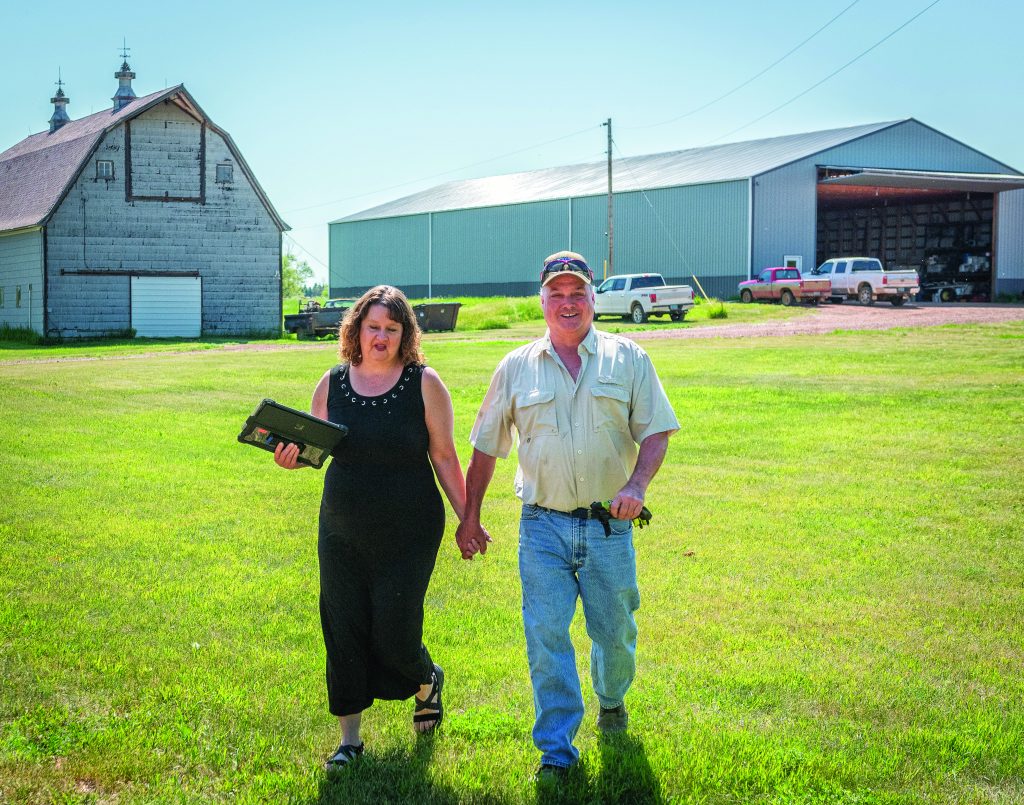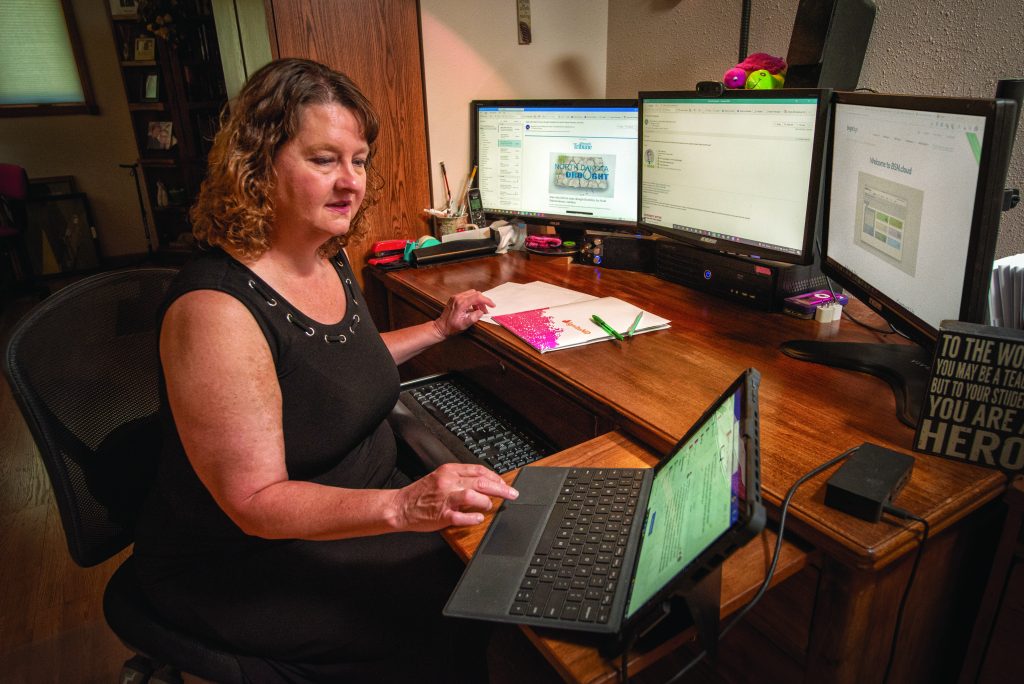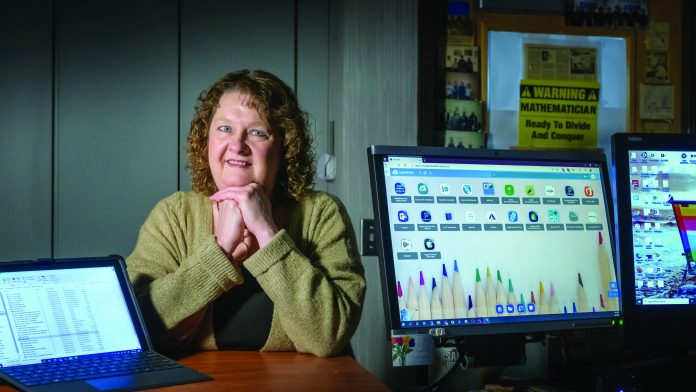The Benefits & Challenges of Online Education
Unlike many teachers, Shannay Witte was well prepared to deal with online instruction during the COVID-19 pandemic. Many K-12 peers struggled to quickly master online instruction, often leading to inconsistent and inadequate student learning experiences nationwide. Through decades in the classroom and teaching remotely with North Dakota’s Center for Distance Education (CDE), Witte developed a digital skillset that enabled her students to continue excelling regardless of the medium of instruction.
Witte grew up on a farm near New England, North Dakota, a small city of 600 residents in sparsely populated southwestern North Dakota. She attended the city’s eponymous elementary and high school. Aspiring to become a teacher, Witte moved to Fargo to study at North Dakota State University (NDSU) in 1984. Since majoring in computer science as a K-12 educator was not an option at the time, she majored in Family and Consumer Science (FACS) with minors in Math and Computer Science.
After graduating, Witte married her high-school sweetheart and moved back to the New England area to teach at the same school where they met. Eventually, they took over her husband’s family small-grains farm, which typically means any grain that can be made into flour or pressed for oil. For the Witte family, this meant growing wheat, flax and canola. The family farm is located a few miles out of town. At the height of their operations, they farmed thousands of acres. The land was initially homesteaded by the Wittes in the late 1800s.
In 1989, Witte began her education career at New England, teaching computer science and middle-school math, and later took over the FACS teaching duties.
In addition, she was and still is the full-time technology coordinator for K-12 in New England, with all grades in one building. For nearly 20 years, she focused on developing her teaching skills, being a parent, helping the family farm be profitable and managing the New England creamery. Witte and her husband raised two children. Her son Alex now works in Fargo, North Dakota, in behavioral health and her daughter Stephanie works in Dickinson, North Dakota, in childcare.
From Salad to Distance Ed
On a summer evening in 2009, Witte was peeling cucumbers in her farmhouse kitchen. The table was covered with the day’s edition of the Dickinson Press. As the peelings piled onto the newsprint, Witte noticed an advertisement for a part-time computer science teacher with North Dakota’s Center for Distance Education (CDE). The advertised position afforded Witte the ability to flex her schedule as needed. She could work with students online and still maintain her full-time teaching position at New England while also working on the family farm. Witte applied the next day.
CDE is North Dakota’s only state-funded distance learning school. It was founded as a correspondence school in 1935 during the height of the Great Depression when many students, especially in rural areas, needed alternative learning opportunities as they worked long hours struggling to keep their family farms viable.
CDE’s mission remains providing quality learning opportunities to students regardless of location, today via online platforms. When Witte was interviewed by CDE’s director in 2009, course enrollments (an enrollment means one student in one course) had declined by 90 percent, from 9,500 to about 1,000 over the previous five years. CDE’s core customers throughout the 1990s and early 2000s were out-of-state students in rural areas. However, CDE’s once-popular print correspondence courses were no longer in demand as other state schools developed online courses.
CDE needed strategic and cultural change. In fact, the state governor’s office considered closing the agency but decided there were serious unmet educational needs statewide. In rural areas, teacher shortages and lack of robust course offerings persisted as problems with no apparent viable solutions. A quality distance learning program held potential to alleviate these concerns.
A new director, Alan Peterson, PhD, was hired for the 2010-11 academic year, at the same time as the state legislature increased funding. This enabled the agency to decrease in-state student tuition and onboard hundreds of additional quality online courses from providers nationwide. High teaching standards for online education were defined clearly, and the agency committed to become fully online, with no print correspondence courses, by 2015. These initiatives focused CDE’s mission on meeting the needs of North Dakota students first.
By the 2013-14 school year, enrollments surpassed 4,500, and the in-state proportion increased to 70 percent. By the 2019-20 school year, just before the pandemic, there were 5,500 enrollments, 80 percent of which were in-state.

Credit: Jerry Anderson
In the summer of 2019, Peterson retired, and I was hired to replace him. I grew up in rural Princeton, Minnesota, and moved to Bismarck, North Dakota, to earn a BA in Social Behavioral Sciences at the University of Mary. Then, for almost 10 years, I taught social studies in grades 9-12 at Red Wing Public High School in Red Wing, Minnesota, as well as coaching football and track. In 2013, my family and I moved to Fargo when I was hired as CDE’s assistant principal. I learned much under Dr. Peterson, as I earned my masters and doctoral degrees in Educational Leadership, and then accepted the challenge of becoming CDE’s next director. My time at CDE helped me reframe how technology can be leveraged in education to provide students with learning experiences that offer greater choice and control over what a student wants to learn and when they learn it.
My first task as CDE’s new assistant principal was to get to know CDE’s part time adjunct teachers. Supervising CDE’s adjunct teacher pool would become my main responsibility. Witte stood out as an exemplar teacher because of her targeted feedback with students and her high level of engagement with her colleagues at CDE.
From Classroom Instructor to Online Facilitator
Witte quickly realized that working at CDE differed significantly from teaching in a traditional classroom. First, students work at their own pace. There are no synchronously taught lessons to larger groups of students meeting together at one time. Second, the online courses are all predesigned and prebuilt online, eliminating the need for daily lesson planning and lectures. Instead, teachers provide detailed feedback to students when they submit work and communicate via multiple mediums, including a Learning Management System, phone, email, text and video conferencing.
This facilitator instruction model enabled Witte to teach a wide range of Information Technology courses, including Middle- and High-School Coding, Game Design, Robotics, AP Computer Science, Computer Programming and Cybersecurity. To date, she has worked online with almost 1,100 students from across North Dakota, as well as from California, Alaska, Germany and South Africa.
Witte soon learned that working with students online from a distance doesn’t prevent building strong relationships. Currently, Emelia Thielman, a 16-year-old homeschooled student in Fargo, is taking the second semester of CDE’s Advanced Placement (AP) Computer Science course with Witte as instructor. In phone and electronic interviews, Emelia said she has always enjoyed math and working with computers, but the first semester of AP Computer Science challenged her. Yet, “I found it be an extremely rewarding experience when you finish a computer program, and it works like it is supposed to,” Emelia said. “Mrs. Witte is great to work with. She is always quick to help with questions and provides extra resources for learning and studying.”
Emelia already has completed 23 of the 22 credits required for graduation in North Dakota, but she still considers herself a high school junior. She looks forward to majoring in forestry or a related field in college.
To help instructors conduct successful academic interventions with students struggling with coursework, CDE developed the Targeted Academic Progress (TAP) form, which creates a repository for each student with information about learning preferences, previous interventions and student feedback after course completion. TAP enables CDE teachers to collaborate regarding what works best for each student, essentially creating a digital version of a Professional Learning Community. The TAP form has played a crucial role in helping increase CDE’s successful course completion rates from 54 to 85.9 percent over the last decade. This equals the average completion rate for similar state-hosted virtual academies, according to the Virtual Learning Leadership Alliance.

Online Education During the Pandemic
In the year before the pandemic, Witte taught FACS, math and computer science at the New England Public School, while also serving as the full-time technology coordinator. In the evenings via CDE, she helped students master competencies in computer science, cybersecurity, coding, robotics and game design.
Then, as spring 2020 approached, the new norm for educators nationwide became “distance learning.” On March 15, Governor Doug Burgum ended in-person learning for the state’s K-12 schools for the rest of the academic year. However, within weeks, schools were expected to reopen with a distance learning plan approved by North Dakota’s Department of Public Instruction.
“Many teachers across the country were asked to be online instructors, and they were not well prepared,” Witte observed. “It was this variability in teacher preparedness that at least partially led to large inconsistencies in a student’s digital experience throughout the pandemic.” Many classroom teachers had little to no experience working with online education and almost instantly had to build engaging lessons with interactive content and live virtual meetings.
In New England, there was no coordinated effort to adopt the same Learning Management System when the pandemic hit. As in many school districts, teachers utilized Schoology, Seesaw, Class Dojo, Google Classroom, Canvas and others, which created confusion and logistical issues with students and their parents.
In the fall of 2020, most students across the country started the school year from home via Zoom and other platforms. New England elementary and high school, however, were fully open. Still, all public schools statewide were required to provide a full-time virtual option for students. According to Witte, only about a dozen of more than 300 students in New England chose to learn virtually.
The pandemic, however, was a key factor that helped convince New England’s education authorities to adopt a 1:1 device policy for students. Every student in grades K-12 is now equipped with a digital device—an iPad for grades K-2 and a small laptop for grades 3-12—to enable both distance learning and hybrid (which blends face-to-face classroom and remote instruction) and distance learning more easily.
“[Digital] devices are really important learning tools for all students,” Witte said, “but students and teachers need to be taught how to use them as educational tools.” The key objective is student mastery of competencies. But the challenge is how to leverage new technologies to help students learn key concepts and then demonstrate mastery of skills. The first hurdle is laying a foundation so that students can access the required course content remotely. This requires that teachers first move course content onto a Learning Management System. However, many teachers are not trained to do so. Prior to the pandemic, Witte had already started moving her course materials onto the Teams Learning Management System for her New England students. As soon as COVID-19 precipitated school closures, Witte helped her New England peers learn how to utilize technology for remote learning and hybrid learning scenarios.
CDE & COVID-19
During the 2020-21 school year, CDE almost doubled in-state course enrollments from the previous year to 10,200. Core subjects such as English and math increased about 325 percent from the previous school year. Enrollment increases in CDE’s computer education courses were not quite as significant, but Witte’s classes grew by 180 percent.
The biggest challenge for Witte and other CDE instructors was dealing with the surge of students who had not taken an online course before. CDE’s research shows that first-time online learners pose the greatest risk of not successfully completing their courses. During the 2020-21 school year, almost 70 percent of CDE enrollments were new online learners. Helping these students often requires longer work hours, increased frequency of communication and different mediums to address even basic online course navigation questions.
For those organizations already providing online distance learning, such as CDE, the COVID-19 pandemic tested capacity and enrollment processes. Other vital components, such as digital curriculum, online teaching methods and technology infrastructure, were already in place. For Witte, being consistently exposed to an online teaching model had provided her with years of experience that at least partially transferred to distance scenarios now playing out in schools across the country.
What many traditional K-12 teachers discovered was that the shift to distance or hybrid learning did not just require them to learn about Learning Management Systems and virtual meeting platforms. Many of the methods that classroom teachers had been using for decades—such as large group lecture, non-verbal feedback cues and student questioning—were suddenly no longer applicable for students learning virtually, since they could progress through content at their own pace.
Students now experience an environment in which traditional barriers, such as seat time and classroom bells, are removed. Also, no longer do teachers remind students about daily lesson objectives, upcoming quizzes or homework assignments. Many of these common stabilizing factors for students are not part of online education, sometimes causing confusion and frustration.
For two decades, educational innovators have been promising a revolution in education via digital delivery and the implementation of adaptive, intelligent software programs. Some educators conclude that the pandemic exposed the weaknesses of potential digital innovations in education. Other experts argue that the pandemic exposed the drawbacks of the traditional classroom. For teachers like Witte, the way forward involves the best of both online and face-to-face instruction.
Benefits & Challenges of Digital Education

We are now at a watershed moment where we can implement positive change that would really benefit students. Most notably, the pandemic provided a catalyst for accelerating educational choice and control for students and their parents, enabling them to leverage new digital technologies. This has been developing gradually over the last decade and is now becoming the norm. Often for the first time, parents and students are realizing that there is reliable technology and infrastructure in place to enable access to increasing inventories of available courses and to enable control over each child’s pace of study.
It’s important to temper this with Witte’s observation that digital devices, educational software and learning platforms, although important learning tools, are still just tools. They must be continuously evaluated regarding how they facilitate student learning.
Digitization doesn’t replace or diminish the fundamental reality that students learn most when there is a caring adult involved in the process. The teacher-student bond is vital for learning, and digital platforms risk failure when human engagement is missing. What prepared Witte to be an effective teacher during the pandemic was both her technological expertise and her well-honed ability to build positive, lasting relationships with students in the classroom and online. The result is students who are well equipped with the academic skills and knowledge they need to be successful.
Matthew Lonn, EdD, is the Director of the North Dakota Center for Distance Education. He earned is Master of Arts in Educational Leadership from Concordia University in St. Paul, MN, and an EdD from the University of Mary in Bismarck, ND. He taught high school social studies and coached football and track and field in Red Wing MN. His report, “Management Systems and Leadership Models in 21st Century Educational Organizations,” was published in the International Journal of Online Graduate Education. In addition, Lonn is a certified Lean Six Sigma Black Belt, which focuses on organizational process improvement to better meet customer/student expectations.

